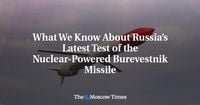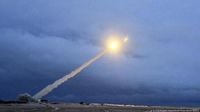Russia’s announcement of a successful test of its nuclear-powered Burevestnik cruise missile—known to NATO as “Skyfall”—has sent ripples through the global security community, igniting fierce debate, political condemnation, and a fresh wave of international anxiety. The test, conducted last week and unveiled by President Vladimir Putin on Sunday, October 26, 2025, marks a dramatic escalation in the ongoing arms race between Moscow and the West, even as the war in Ukraine drags into its fourth year.
According to a video released by the Kremlin, the Burevestnik missile flew an astonishing 8,700 miles (or roughly 14,000 kilometers) over a 15-hour period, a feat that, if independently verified, would set a new benchmark for missile endurance and range. General Valery Gerasimov, Russia’s Chief of the General Staff, told Putin during the announcement that “that’s not the limit,” hinting at even greater capabilities. The missile reportedly completed all prescribed vertical and horizontal maneuvers, demonstrating what Russian officials claim is a high capacity to evade missile-defense and air-defense systems—a chilling prospect for adversaries.
“This is indeed a unique weapon that no other country possesses,” Putin declared, clad in camouflage, in a moment clearly designed to project strength and technological prowess. The Burevestnik, which means “storm petrel” in Russian, is powered by a miniature nuclear reactor—essentially a tiny nuclear power plant that heats air to drive a ramjet engine. This design, according to Russian military officials, gives the missile virtually unlimited range and the ability to loiter for extended periods, flying low across terrain to avoid detection.
But the test, which Norway confirmed took place on the remote Novaya Zemlya archipelago in the Barents Sea, has drawn sharp criticism and skepticism from Western leaders and experts. President Donald Trump, speaking to reporters aboard Air Force One while traveling from Kuala Lumpur to Tokyo, did not mince words. “You’ve got to get the war ended. A war that should have taken one week is now in its soon fourth year,” Trump said, rebuking Putin for focusing on missile tests instead of peace negotiations in Ukraine. “We test missiles all the time. They’re not playing games with us, and we’re not playing games with them either.”
Trump, who was on the Japan leg of his Asia tour, also pointed out that the U.S. possesses what he called “the greatest nuclear submarine in the world, right off their shore,” suggesting that America’s own deterrent capabilities make such long-range missile developments unnecessary. “We don’t need to go 8,000 miles,” he added, dismissing the strategic necessity of Burevestnik’s touted range.
The Kremlin, for its part, tried to downplay the diplomatic fallout. Dmitry Peskov, Putin’s spokesperson, told reporters on Monday that “there is nothing here that could or should further strain relations between Moscow and Washington, especially since they are already at a minimum,” according to Russian state news agency TASS. Peskov later emphasized Russia’s commitment to its own national interests, especially in the face of what he described as “militaristic sentiment we are currently hearing primarily from Europeans.”
Yet, the timing of the test and its public unveiling have not gone unnoticed. Many analysts see the announcement as a direct response to recent U.S. and European sanctions on Russia, as well as to American plans for a new “Golden Dome” missile defense system. The U.S. imposed significant new sanctions last week targeting Russia’s major oil firms and their subsidiaries, a move Treasury Secretary Scott Bessent said would “increase pressure on Russia’s energy sector and degrade the Kremlin’s ability to raise revenue for its war machine and support its weakened economy.” The European Union quickly followed suit with its 19th sanctions package, targeting Russia’s energy, military, and financial sectors, and individuals linked to the abduction of Ukrainian children.
The Burevestnik missile’s development, however, has not been without controversy or tragedy. Both the United States and the Soviet Union experimented with nuclear-powered cruise missile technology during the Cold War, only to abandon it over safety and reliability concerns. Those fears were realized in 2019, when a failed Russian test is believed to have caused an offshore explosion in the Arctic, killing five scientists and causing a spike in radiation levels in a nearby city. The U.S. government has since pointed to that incident as evidence of the grave risks posed by such technology.
Western experts remain deeply divided over the missile’s real value. Some, like Pavel Podvig of the United Nations Institute for Disarmament Research, argue the Burevestnik is “largely political,” serving more as a symbol of Kremlin bravado than a practical battlefield asset. “The main reason that no one else has tried to build something like this is that it doesn’t really have any use,” Podvig told NBC News, noting that the weapon’s unique features are outweighed by its vulnerabilities—especially its susceptibility to detection and attack during its long flight times. Others, such as Fabian Hoffmann of the Oslo Nuclear Project, go so far as to mock the program: “I celebrate every ruble Russia invests in this useless and unnecessary missile,” he posted to social media.
Still, Russian military leaders insist the Burevestnik is a game-changer. General Gerasimov described its “assured accuracy against highly protected targets at any range,” and emphasized its ability to evade Western missile defenses. The missile is designed as a so-called “second strike” weapon, part of Russia’s strategy to ensure a retaliatory capability in the event of a nuclear attack. But as Podvig and others point out, any such scenario would likely see Burevestnik launch sites targeted in the opening moments of a conflict, limiting its real-world utility.
In addition to the Burevestnik, Russia’s recent round of strategic nuclear force training included tests of Yars and Sineva intercontinental ballistic missiles, as well as two Kh-102 air-launched cruise missiles, underscoring Moscow’s intent to showcase the breadth of its nuclear arsenal. The Kremlin’s message, it seems, is as much about political theater as military might—an attempt to assert Russian technological leadership and resilience in the face of Western pressure.
For now, the Burevestnik test stands as both a technical milestone and a stark reminder of the risks inherent in the renewed arms competition. As the war in Ukraine grinds on and diplomatic relations remain frosty, the world is left to grapple with the question: Is this the dawn of a new era in nuclear brinkmanship, or simply a costly display of bravado with little real impact on the balance of power?
Whatever the answer, the test has sharpened the stakes and raised the temperature in an already volatile geopolitical landscape—reminding all sides that the specter of nuclear escalation, however remote, is never far from the surface.





